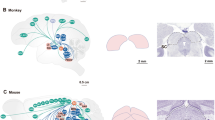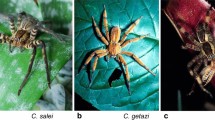Summary
-
1.
The nature of the synaptic relationship between 7 identified postural interneurons and 5 pairs of superficial motoneurons was examined by obtaining dual intracellular recordings from interneuron-motoneuron pairs in the lobster 2nd abdominal ganglion.
-
2.
For six different interneuron-motoneuron pairs EPSPs recorded from motoneurons occurred with a short (1 to 3 ms) fixed latency following each presynaptic spike recorded from the interneuron. This suggests that there is a monosynaptic relationship between these interneurons and motoneurons. Monosynaptic pathways accounted for 27% of all excitatory connections.
-
3.
Preliminary evidence indicates that the monosynaptic potentials are mediated by an excitatory chemical synapse since: 1) all IPSPs occurred with latencies greater than 5 ms, 2) there was no evidence for electrical coupling, and 3) one of the interneurons produced facilitating PSPs.
-
4.
A majority of all monosynaptic connections were made by two of the flexion producing interneurons (FPIs), 201 and 301. The synaptic outputs of these FPIs were similar in that both made monosynaptic connections with a different bilaterally homologous pair of motoneurons. Both also produced larger EPSPs and more vigorous spiking in contralateral members of the bilateral motoneuron pairs.
-
5.
A previous study demonstrated that interneurons 201 and 301 are the only postural interneurons yet identified that express motor programs indistinguishable from command neurons. Taken together, these results suggest that certain intersegmental interneurons share properties with command neurons and driver neurons, and that there may not be a sharp morphological or functional distinction between these two cell types.
Similar content being viewed by others
Abbreviations
- 2 :
-
second root
- s3 :
-
third root, superficial branch
- A1, A2, A3, A4 :
-
first, second, third, fourth abdominal ganglia
- AC :
-
anterior connective
- c :
-
contralateral
- cm :
-
current monitor
- EPI :
-
extension producing interneuron
- FPI :
-
flexion producing interneuron
- i :
-
ipsilateral
- L :
-
left
- PC :
-
posterior connective
- R :
-
right
- SEMN :
-
superficial extensor motoneurons (el-e6)
- SFMN :
-
superficial flexor motoneurons (f1-f6)
- T5 :
-
fifth thoracic ganglion
References
Berry MS, Pentreath VM (1976) Criteria for distinguishing between monosynaptic and polysynaptic transmission. Brain Res 105:1–20
Evoy WH, Kennedy D (1967) The central nervous organization underlying control of antagonistic muscles in the crayfish. I. Types of command fibers. J Exp Zool 165:223–238
Getting PA (1981) Mechanisms of pattern generation underlying swimming inTritonia. I. Neuronal network formed by monosynaptic connections. J Neurophysiol 46:65–79
Harris-Warrick RM (1985) Amine modulation of extension command fiber-evoked motor activity in the lobster abdomen. J Comp Physiol A 156:875–884
Harris-Warrick RM, Kravitz EA (1984) Cellular mechanisms for modulation of posture by octopamine and serotonin in the lobster. J Neurosci 4:1976–1993
Jellies J, Larimer JL (1985) Synaptic interactions between neurons involved in the production of abdominal posture in crayfish. J Comp Physiol A 156:861–873
Jones K, Page CH (1983) Differential backfilling of interneuron populations based upon axon projections in a lobster abdominal ganglion. J Neurobiol 14:441–456
Jones KA, Page CH (1968a) Postural interneurons in the abdominal nervous system of lobster; I. Organization, morphologies and motor programs for flexion, extension and inhibition. J Comp Physiol A 158:259–271
Jones KA, Page CH (1986b) Postural interneurons in the abdominal nervous system of lobster: III. Pathways mediating intersegmental spread of excitation. J Comp Physiol A 158:281–290
Kennedy D, Evoy WH, Hanawalt JT (1966a) Release of coordinated behavior in crayfish by single central neurons. Science 154:917–919
Kennedy D, Evoy WH, Fields HL (1966b) The unit basis of some crustacean reflexes. Symp Soc Exp Biol 20:75–109
Kennedy D, Evoy WH, Dane B, Hannawalt JT (1967) The central nervous organization underlying control of antagonistic muscles in the crayfish. II. Coding of position by command fibers. J Exp Zool 165:239–248
Kravitz EA, Glusman S, Harris-Warrick RM, Livingstone MS, Schwarz T, Goy MF (1980) Amines and a peptide as neurohormones in lobsters: actions of neuromuscular preparations and preliminary behavioural studies. J Exp Biol 89:159–176
Larimer JL, Eggleston AC (1971) Motor programs for abdominal positioning in crayfish. Z Vergl Physiol 74:388–402
Livingstone MS, Harris-Warrick RM, Kravitz EA (1980) Serotonin and octopamine produce opposite postures in lobsters. Science 208:76–79
Maynard DM, Selverston AI (1975) Organization of the stomatogastric ganglion of the spiny lobster. IV. The pyloric system. J Comp Physiol 100:161–182
Miall RC, Larimer JL (1982) Central organization of crustacean abdominal posture motoneurons: connectivity and command fiber inputs. J Exp Zool 224:45–56
Otsuka M, Kravitz EA, Potter DD (1967) Physiological and chemical architecture of a lobster ganglion with particular reference to gamma-aminobutyrate and glutamate. J Neurophysiol 30:725–751
Page CH, Jones KA (1982) Abdominal motoneuron responses elicited by flexion of a crayfish leg. J Exp Biol 99:339–347
Rall W (1970) Cable properties of dendrites and effects of synaptic location. In: Andersen P, Jansen JKS (eds) Excitatory synaptic mechanisms. Universitetsforlaget, Oslo, pp 175–187
Rall W, Burke RE, Smith TG, Nelson PG, Frank K (1967) Dendritic location of synapses and possible mechanisms for the monosynaptic EPSP in motoneurons. J Neurophysiol 30:1169–1193
Robertson RM, Pearson KG (1985) Neural circuits in the flight system of the locust. J Neurophysiol 53:110–128
Sokolove PG, Tatton WG (1975) Analysis of postural motoneuron activity in crayfish abdomen. I. Coordination by premotoneuron connections. J Neurophysiol 38:313–331
Tatton WG, Sokolove PG (1975) Analysis of postural motoneuron activity in crayfish abdomen. II. Coordination by excitatory and inhibitory connections between motoneurons. J Neurophysiol 38:332–346
Thompson CS, Page CH (1981) Interneuronal control of postural motoneurons in the lobster abdomen. J Neurobiol 12:87–91
Thompson CS, Page CH (1982) Command fiber activation of superficial flexor motoneurons in the lobster abdomen. J Comp Physiol 148:515–527
Author information
Authors and Affiliations
Rights and permissions
About this article
Cite this article
Jones, K.A., Page, C.H. Postural interneurons in the abdominal nervous system of lobster. J. Comp. Physiol. 158, 273–280 (1986). https://doi.org/10.1007/BF01338570
Accepted:
Issue Date:
DOI: https://doi.org/10.1007/BF01338570




